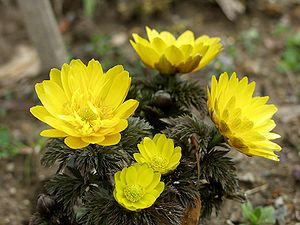Amur Adonis
| Amur Adonis | ||||||||||||
|---|---|---|---|---|---|---|---|---|---|---|---|---|

Amur Adonis ( Adonis amurensis ) |
||||||||||||
| Systematics | ||||||||||||
|
||||||||||||
| Scientific name | ||||||||||||
| Adonis amurensis | ||||||||||||
| Rule & Radde |
The Amur-Adonisröschen ( Adonis amurensis Regel & Radde) is a species of the genus Adonisröschen ( Adonis ) and belongs to the buttercup family (Ranunculaceae). Because the flowering often begins in February, Adonis amurensis is a spring bloomer like the winterling ( Eranthis hyemalis ) .
description
The Amur Adonis rose grows as a compact, perennial herbaceous plant that reaches heights of 5 to 15 cm in the flowers and grows fruitfully up to 30 cm. A short and thick rhizome is formed as a permanent organ. The hairless stems are rarely branched and have membranous scales at their base. During the flowering period, the hairless leaves are not yet fully expanded. The leaf stalks are up to 6.5 cm long. The triangular, finely divided two- to three-fold pinnate leaf blade is about 7.5 × 9 cm in size. The pinnate sections are long stalked, the last order pinna are narrowly ovate or lanceolate and pointed.
The hermaphrodite flowers are 2.8 to 3.5 cm in diameter. The approximately nine sepals are 1.4 to 1.8 cm long, oblong to ovoid-oblong, light grayish-purple and at most sparsely hairy. The approximately ten petals are obovate-oblong to narrowly lanceolate, hairless, 1.4 to 2 × 0.5 to 0.7 cm in size and yellow. The numerous, hairless stamens are 3 mm long. The approximately 0.8 mm long, curved style ends in a spherical scar. The nuts , arranged in a spiral in a collective fruit , are obovate, about 3.8 mm long and have downy hairs.
The flowering period extends from March to April, but can also start earlier in February. The plant moves in after flowering in May to June.
The number of chromosomes is 16, 24, 32 or 40.
Occurrence
Adonis amurensis was named after the Amur region , but is also common in other parts of East Asia. The total distribution area extends from eastern Siberia over Manchuria (the Chinese provinces of eastern Heilongjiang , Jilin and Liaoning ) and Korea to Japan . In China, Adonis amurensis thrives in forests and on grassy slopes.
ingredients
Like most species of Adonis, the Amur Adonis contains toxins. Since the cardiac glycoside adonitoxin u. a. contained in the roots, it is also used as a heart stimulant.
Systematics
Adonis amurensis was first published in 1861 by Eduard August von Regel and Gustav Radde . Synonyms for Adonis amurensis Regel & Radde are Adonis vernalis L. var. amurensis (Regel & Radde) Finet & Gagnepain , Adonanthe amurensis (Regel & Radde) Chrtek & Slavikova and Chrysocyathus amurensis (Regel & Radde) Holub .
Garden culture
Plants have been cultivated under the name Amur Adonis since around 1895. The species was probably never cultivated to any significant extent in Europe. It is difficult to cultivate because of a narrow ecological amplitude in terms of light and soil moisture. Barlage's Big Book of Garden Flowers calls the flowers “unusually beautiful eye-catchers in the spring garden.” They are uncomplicated, but love moist soil in spring and are prone to snail damage. Propagation by division is easier than sowing. You need 16 plants per square meter. Heard as " Adonis amurensis ". Sterile, vegetatively propagated hybrids of Adonis multiflora × Adonis ramosa , in which “real” Adonis amurensis is not involved, are also sold. One variety of this hybrid is Adonis 'Fukujukai'.
swell
- Fu Dezhi, Orbélia R. Robinson: Adonis amurensis. . In: Wu Zhengyi, Peter H. Raven, Deyuan Hong (Eds.): Flora of China . Volume 6: Caryophyllaceae through Lardizabalaceae . Science Press / Missouri Botanical Garden Press, Beijing / St. Louis 2001, ISBN 1-930723-05-9 , pp. 390 (English, PDF file ).
- Fritz Encke : Parey's flower nursery . tape 1 . Paul Parey , Berlin 1960, p. 655 .
- Johannes Kreuzer: Kreuzer's garden plant lexicon "in a nutshell": shrubs, grasses, ferns, aquatic plants . 5th edition. tape 2 . Thalacker, Braunschweig 1982, ISBN 3-87815-028-8 , p. 14 .
Individual evidence
- ↑ a b c d e f g Fu Dezhi, Orbélia R. Robinson: Adonis amurensis. . In: Wu Zhengyi, Peter H. Raven, Deyuan Hong (Eds.): Flora of China . Volume 6: Caryophyllaceae through Lardizabalaceae . Science Press / Missouri Botanical Garden Press, Beijing / St. Louis 2001, ISBN 1-930723-05-9 , pp. 390 (English, PDF file ).
- ↑ a b Eckehart J. Jäger, Friedrich Ebel, Peter Hanelt, Gerd K. Müller (eds.): Exkursionsflora von Deutschland . Founded by Werner Rothmaler. tape 5 : Herbaceous ornamental and useful plants . Springer, Spektrum Akademischer Verlag, Berlin / Heidelberg 2008, ISBN 978-3-8274-0918-8 , pp. 150 .
- ↑ a b Adonis amurensis at Tropicos.org. Missouri Botanical Garden, St. Louis
- ↑ japan. Page ( Memento from June 3, 2006 in the Internet Archive )
- ↑ Eduard August von Regel : List of the plants from Radde in Baikal, Dahuria and on the Amur, as well as from Mr. von Stubendorff on his journey through Siberia to Kamchatka, and the plants collected by Rieder, Kussmisscheff and others in Kamchatka. 1st Dept. Dicotyledoneae. Polypetalae. In: Bulletin de la Société impériale des naturalistes de Moscou. Volume 34, No. 2, 1861, pp. 1–211 (here, pp. 35 ff., Panel 2, figure 1, 2a – b ff.), Preview in the Google book search
- ↑ a b Adonis amurensis ( Memento from February 20, 2009 in the Internet Archive ) at www.stauden.de (website of the Association of German Perennial Gardeners )
- ^ Andreas Barlage, Frank M. von Berger: The great book of garden flowers. Over 2000 perennials, summer flowers, bulb plants and grasses. Ulmer, Stuttgart 2016, ISBN 978-3-8001-3394-9 , p. 115.

